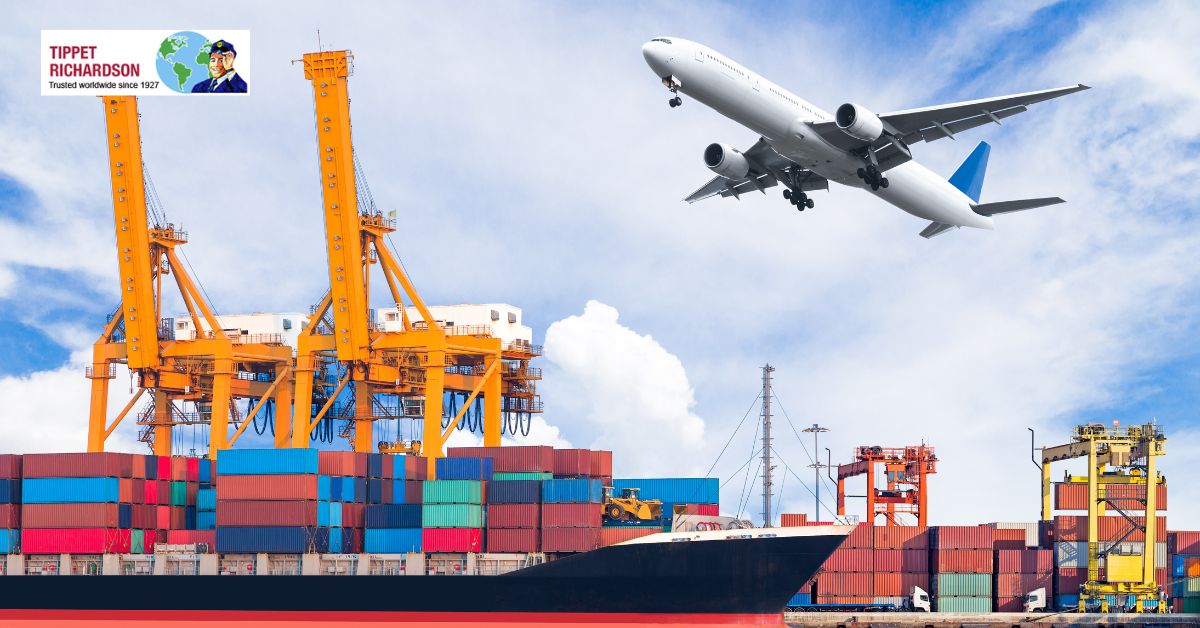Moving internationally from Toronto involves carefully selecting the right shipping method to ensure your belongings arrive safely, on time, and within budget. When considering air vs sea international moving, it’s essential to understand how each option aligns with your unique needs, timeline, and the nature of your shipment. Tippet Richardson, a respected Toronto-based moving company since 1927, specialises in guiding clients through these important decisions.
Air freight, often referred to as express freight, offers unparalleled speed, making it ideal for those with tight schedules or valuable belongings that require swift handling. It’s a preferred choice for smaller shipments or items that are time-sensitive, though this convenience comes at a higher cost. On the other hand, sea freight provides cost-effective ocean cargo options, capable of transporting large volumes of household goods or commercial inventory. This method is well-suited for moves where budget-conscious planning and bulk shipping are priorities, even if transit times are longer.
Navigating between these two methods means balancing speed, cost, capacity details such as customs clearance and packaging requirements. Toronto’s major airports and seaports serve as critical hubs for international moving, offering various routes and services that factor into this choice. With nearly a century of experience, Tippet Richardson understands the nuances of both air and sea freight from Toronto and helps customers select solutions that combine reliability with flexibility.
Whether you prioritise express freight’s rapid transit or the affordability of ocean cargo options, this guide will equip you with the knowledge to make an informed decision. By considering factors such as shipment size, destination, timing, and budget, you can choose the international moving service best fit for your circumstances. Tippet Richardson remains committed to delivering a seamless moving experience, ensuring every detail of your international relocation is carefully managed from start to finish.
Read Also: How to Choose the Best Student Moving Services Annex
Understanding Air vs Sea International Moving from Toronto
When planning an international move from Toronto, comprehending the core differences between air vs sea international moving is crucial. Each method involves distinct processes, shipment types, and timelines that can significantly influence your relocation experience.
What Does Air Freight Involve?
Air freight is the transportation of goods via aircraft, offering one of the fastest ways to move belongings worldwide from Toronto. Typically, items suited for air freight include small to medium-sized shipments, time-sensitive cargo, high-value possessions, and essential documents or equipment. Because air freight prioritises speed, shipments undergo meticulous handling and faster customs clearance.
In Toronto, goods designated for air freight usually depart from Toronto Pearson International Airport. The shipping process involves carefully packing items into air-approved containers, weighing and measuring each parcel to comply with airline regulations. Once items clear customs, they are loaded onto cargo planes destined for international airports near your final location. The efficiency of express freight solutions means transit times can be a few days to a couple of weeks, depending on the destination.
What Are Sea Freight (Ocean Cargo) Options?
By contrast, sea freight moves goods via large cargo ships and is typically the preferred choice for substantial or bulky shipments. Ocean cargo options from Toronto rely on the city’s proximity to major ports such as the Port of Toronto on Lake Ontario, which connects to the global container shipping network via the St. Lawrence Seaway and other transshipment hubs.
Sea freight generally offers two primary container options: full container load (FCL) and less than container load (LCL). FCL allows you to rent an entire container exclusively for your goods, ideal for large household moves. Alternatively, LCL combines smaller shipments with others, reducing costs but sometimes increasing transit times due to consolidation processes.
Cargo is securely packed into containers, then transported to port terminals for loading onto ocean vessels. The journey by sea often spans several weeks, depending on the route and destination port. Despite the longer transit, ocean cargo options are considerably more economical, accommodating diverse cargo types including vehicles, furniture, and non-perishable goods.
Key Differences Between Air and Sea Freight
When comparing air vs sea international moving from Toronto, several factors stand out:
– Speed: Air freight is substantially faster, making it suitable for urgent shipments, while sea freight takes longer but is suitable for less time-sensitive moves.
– Cost: Air freight commands higher prices due to express freight services and limited cargo space, whereas sea freight offers a cost-efficient choice for bulk shipments.
– Capacity: Air freight restricts the size and weight of shipments, while ocean cargo allows for large volumes and heavy goods.
– Customs and Documentation: Both methods require customs clearance, but air freight often benefits from streamlined processing protocols, expediting import/export handling.
– Reliability: Air freight schedules generally maintain regularity and predictability, while sea freight may face delays caused by weather, port congestion, or route changes.
Understanding these distinctions helps Toronto residents collaborate with professionals like Tippet Richardson, whose experience ensures tailored recommendations based on your shipment size, timeline, and budget. By qualifying your priorities, you can select either express freight or ocean cargo options that provide the best balance for your international move.
When to Choose Air Freight for Your International Move
Deciding between air vs sea international moving often hinges on your need for speed, security, and shipment size. Air freight stands out as the go-to solution for those seeking fast, dependable international relocation from Toronto, especially when time is of the essence.
Advantages of Air Freight
Air freight provides the most rapid transit times among international shipping methods. By utilising express freight services, your belongings can reach destinations worldwide within days, a stark contrast to the weeks-long journey of ocean cargo options. This expedited timeline benefits those who cannot afford long wait periods or need quick access to essential items.
Additionally, air freight offers heightened security and careful handling. Cargo is often stored in secure, climate-controlled environments and handled by trained personnel familiar with air transport’s strict safety standards. This reliability reduces the risk of damage or loss, providing peace of mind for high-value or fragile possessions.
Furthermore, air freight’s scheduled flights and extensive airport networks mean consistent availability and flexibility. For Toronto movers, express freight can be arranged easily via Pearson International Airport, streamlining pick-up and delivery to meet tight deadlines.
Situations Best Suited for Air Freight
Air freight excels in support of relocations requiring urgency. Families or professionals moving for unexpected job transfers, international students needing to arrive with personal items promptly, and small-volume shipments all benefit from the speed of air transport.
Moving valuable items like artwork, electronics, or important documents are also prime candidates for air freight. Its rapid transit and secure handling ensure these items reach their destination safely and on time.
Similarly, if your shipment includes perishable goods or items sensitive to environmental factors, express freight helps maintain condition and freshness due to faster delivery and better control throughout transit.
Cost Considerations of Air Freight
While the advantages of air freight are clear, it is important to understand the associated costs. The price of air international moving from Toronto tends to be higher than sea freight, reflecting the need for quicker handling, specialised packaging, and limited cargo space on planes.
Pricing factors include the weight and volume of your shipment, destination airport fees, fuel surcharges, and customs processing expenses. Because of these variables, air freight is usually most cost-effective for smaller, lighter loads or when urgency outweighs budget concerns.
Tippet Richardson works closely with Toronto clients to assess their specific shipment parameters and budget constraints, helping to optimise the use of air freight while controlling expenses. Their expertise ensures the selection of express freight solutions that balance speed with affordability, making international moves smoother and more predictable.
Choosing air freight as part of your international moving plan from Toronto guarantees a swift and secure journey for your belongings, especially when time and care are paramount.
When Sea Freight is the Best Ocean Cargo Option
For many international moves from Toronto, sea freight stands out as the most practical and economical choice. Understanding when and why to select ocean cargo options can save you significant costs while meeting the demands of bulk shipments and less urgent timelines.
Benefits of Sea Freight for International Moves
Sea freight is widely recognised for its affordability, especially when transporting large volumes of goods. Compared to air freight, ocean cargo options offer much lower rates per cubic metre, making them ideal for families moving extensive household items, furniture, or inventory overseas.
Another advantage is the sheer capacity sea freight provides. Massive cargo ships can accommodate full container loads (FCL) or consolidate smaller shipments in less than container loads (LCL), offering flexible solutions tailored to your shipment size. This capacity means that more items can be transported together securely and efficiently.
Moreover, sea freight tends to have a smaller environmental footprint than air freight. Shipping by ocean reduces carbon emissions per kilogram of cargo, appealing to environmentally conscious movers in Toronto aiming for greener relocation options.
Ideal Scenarios for Using Sea Freight
Sea freight is best suited for moves where timing is flexible and volume is substantial. If your international relocation from Toronto does not require immediate delivery, ocean cargo options provide a cost-effective solution without compromising on safety or reliability.
Large-scale moves such as entire household shipments, including bulky furniture and vehicles, often rely on sea freight to accommodate their size and weight.
Families planning long-distance moves can benefit greatly from sea freight if they are willing to allow extra transit time. This approach not only reduces moving costs but ensures all possessions arrive together in one consolidated shipment, simplifying the unpacking process.
Factors Affecting Sea Freight Costs and Timing
The cost and duration of sea freight from Toronto depend on several important factors. Container types—whether full containers or shared loads—affect pricing; an FCL offers exclusive use but at a higher fixed cost, while LCL spreads costs by sharing space with other shipments, though it may extend transit times due to consolidation.
Port fees and handling charges at both origin and destination ports also influence the final cost. Toronto’s proximity to major shipping hubs in the Great Lakes region facilitates access to efficient routes but fees can vary by port and carrier.
Routing plays a crucial role as well. Direct sea routes typically offer faster delivery but at a premium, while transshipment routes with intermediary stops are usually cheaper but lengthen transit time.
Navigating these ocean cargo options and factors can be complex, which is why Tippet Richardson’s expertise as a Toronto international mover ensures clients receive tailored advice. By selecting the optimal sea freight configuration, you can balance cost and timing to achieve a seamless, stress-free overseas relocation.
Read Also: Customs Clearance International: Steps for Hassle-Free Move
Making the Right Choice Between Air and Sea Freight
Choosing between air vs sea international moving is a nuanced decision that depends largely on your personal priorities. Carefully weighing factors like speed, cost, shipment size, and flexibility can help you select the option that best matches your unique moving goals from Toronto.
Assessing Your Moving Priorities
Begin by clarifying what matters most in your move. If arriving quickly is your top priority, air freight with its express freight advantages is the natural choice despite a higher price point. Conversely, if managing your budget is critical and you have a larger or heavier shipment, sea freight offers the affordability and capacity needed for extensive moves.
Consider also your flexibility with delivery timelines. Sea freight demands a longer transit window, so if your schedule can accommodate several weeks to a few months for shipment arrival, it provides great value. For those requiring tight deadlines, air freight ensures speed and predictability.
Combining Air and Sea Freight Solutions
In many cases, a hybrid approach combining both air and sea freight optimises results. For example, critical or high-value items can be shipped via express freight from Toronto to reach the destination quickly, while bulkier, less urgent inventory travels by ocean cargo, balancing cost and speed.
This blended strategy offers flexibility and efficiency. It allows movers to prioritise which belongings arrive first without incurring the full expense of all air freight shipments. Tippet Richardson regularly helps clients design these customised relocation plans, coordinating seamless transitions between air.
Working with Professional International Movers
Tippet Richardson, with its nearly 100 years of service in Toronto, provides tailored guidance to match your moving needs with the ideal freight method. Their team assesses your shipment details, destination specifics, and timeline to recommend either air or sea freight, or a mix of both.
Beyond transport, Tippet Richardson manages customs clearance, scheduling, packaging standards, and compliance with international regulations—critical factors in ensuring smooth delivery. Their experience helps eliminate surprises, giving you confidence your international move from Toronto will be handled efficiently and professionally.
Ultimately, making the right choice between air and sea freight hinges on understanding your priorities and leveraging expert advice. With Tippet Richardson’s support, you gain a customised approach that maximises the benefits of express freight speed and ocean cargo affordability, resulting in a stress-free and successful international relocation.
Also Read: Your Complete Container Size Guide International Moving
Wrapping Up
Choosing between air vs sea international moving is a critical step in ensuring a successful relocation from Toronto. Each method comes with its distinct advantages and trade-offs, and the right choice ultimately depends on your personal priorities such as timing, budget, and the size or type of your shipment.
With nearly 100 years of experience, Tippet Richardson brings trusted expertise to guide you through these decisions. Whether you require the rapid speed and security of express freight or the cost-effective efficiency of ocean cargo options, we help coordinate every detail to simplify your move.
Partnering with professional international movers like Tippet Richardson means gaining access to comprehensive services — from expert packing and seamless customs clearance to flexible scheduling and reliable delivery. You can trust that your belongings will be handled with care and professionalism, no matter which shipping method you choose.
Ultimately, understanding the differences between air and sea freight empowers you to make confident decisions and avoid costly surprises. Tippet Richardson is committed to supporting Toronto residents throughout the entire journey, providing the knowledge and resources necessary to ensure your international move is smooth, secure, and customised to your goals.





